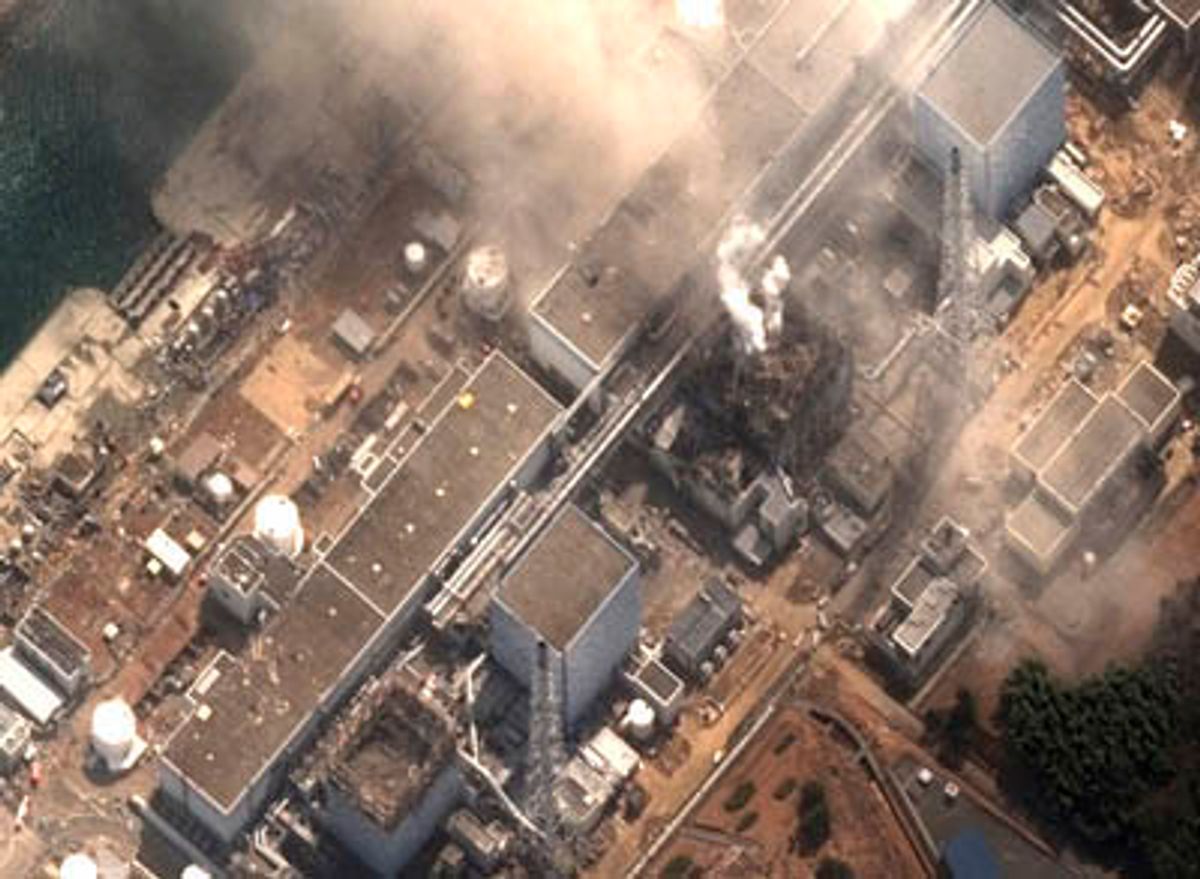Editor's Note: This is part of IEEE Spectrum's ongoing coverage of Japan's earthquake and nuclear emergency.
Fire-fighting crews from Tokyo resumed pumping seawater into the No. 3 reactor building of the stricken Fukushima Dai-1 Nuclear Power Station Saturday morning. A new round of pumping was planned for the afternoon. Meanwhile, power company worker have been working around the clock laying cables from the electricity grid to the plant and then to the six reactors. During the day, they reported some success in restoring power, essential for operating the reactors' and spent fuel pools’ cooling systems.
A morning operation conducted by fire fighters sent from Tokyo poured 60 metric tons of water into the No. 3 reactor building, aiming to refill the spent fuel storage pool that lost water after power failed following the 11 March earthquake and tsunami. Without power to drive water circulation the still-rdioactive spent fuel will gradually heat up and evaporate the water. NHK, Japan’s national broadcaster, reported the water injection operation took 20 minutes.
Meanwhile, Tokyo Electric Power Co. (TEPCO) crews worked to bring in power from an outside Tohoku Electric Power Co. electricity grid line to a reserve transformer located some distance from the plant. The idea is to use the transformer to provide electricity for the plant. The crews then laid down cable in a circuitous route around debris caused by explosions that have damaged the No. 1 and No. 3 reactors. The cable had to be laid down in two stages of 550 meters and 930 meters before the crews were able to connect it to a temporary transformer installed next to the No. 1 reactor.
An NHK expert following events at the plant said this part of the operation was completed Friday night. He added that TEPCO expected to finish installing a link from the temporary transformer to the transformer for the No. 2 reactor by Saturday morning. But high radiation is hampering the crew and the work was still ongoing Saturday afternoon. The No. 2 reactor is considered to be in a dangerous state after an earlier hydrogen explosion is believed to have damaged the suppression pool, or torus, which is connected to the primary containment vessel where nuclear fission takes place. The torus serves a safety function: If pressure rises too high in the pressure vessel, operators can vent steam into the torus through a series of relief valves. Pressure in the vessel is reported to be down since the explosion.
A Nuclear and Industrial Safety Agency official said in a press conference Saturday morning that because the No. 2 reactor building “isn’t damaged (by the explosion) it’s difficult to inject water into it from outside. So it is necessary to restore the cooling system by repairing the power station.” He added that about 20 people are working on this reactor. But radiation is hampering progress. Radiation of 10 millisieverts per hour had been measured outside No. 1 reactor and 15 millisieverts per hour outside No. 2 reactor.
One hundred millisieverts had been the maximum amount of radiation a worker should be exposed to during one stint. But Saturday morning a company official said that it had now raised the maximum level to 150 millisieverts because of the emergency.
But not all the news on radiation was bad. Gregory Hartl, an official with the World Health Organization, commented on the endangered plant in Geneva Friday. “Outside the 30 km radius there have been very low levels of radiation measured.” He added that “the evidence so far (with) the radiation levels measured would say there is little public health danger from the radiation there.”
More positive news came during the day when NHK reported that other TEPCO repair groups were using existing cables at the plant to link reactors 3, 4, 5 and 6 to power sources outside the plant. Later that afternoon a Nuclear and Industrial Safety Agency official announced that Tepco workers had used an emergency diesel generator to restore some power to the No. 5 reactor and No. 6 reactor buildings. It had been reported earlier that the water in the spent fuel storage pools had been heating up there, as well.
The situation brightened further when around 2 p.m. an unmanned Tokyo fire truck with a 22-meter water tower began shooting a stream of seawater—at a rate of 3 tons a minute—into the No. 3 reactor building. The truck was connected by a 300- meter hose to second truck positioned near the ocean that used a high-pressure pump to provide it with water. NHK reported the operation would continue for seven hours. Providing the operation continues without interruption, some 1200 tons of seawater would be jetted into the building. The spent fuel storage pool is rated to hold 1200 tons of water, according to NHK.
Kazuaki Matsu, executive managing director of the Institute of Applied Energy, an independent organization in Tokyo, told Spectrum that even if they were to fill only one third of the pool, it would probably be enough to cover the top of the spent fuel rods. “For purposes of cooling the rods about one-third would be sufficient. But for radiation shielding purpose, 1200 would be perfect.”
Several hours after the operation began, government officials announced the operation was going smoothly. In a press conference held at 3:30 p.m. Defense Minister Toshimi Kitazawa showed dramatic video of the Self-Defense fire trucks taking part in yesterday’s operation. A video camera was mounted in one of the trucks and showed another truck parked within 20 to 30 meters of the No. 3 reactor pumping water into the building. The video showed shattered walls, mangled broken pipes and mangled steel bars once used to reinforce the concrete walls.
Photo: TEPCO





